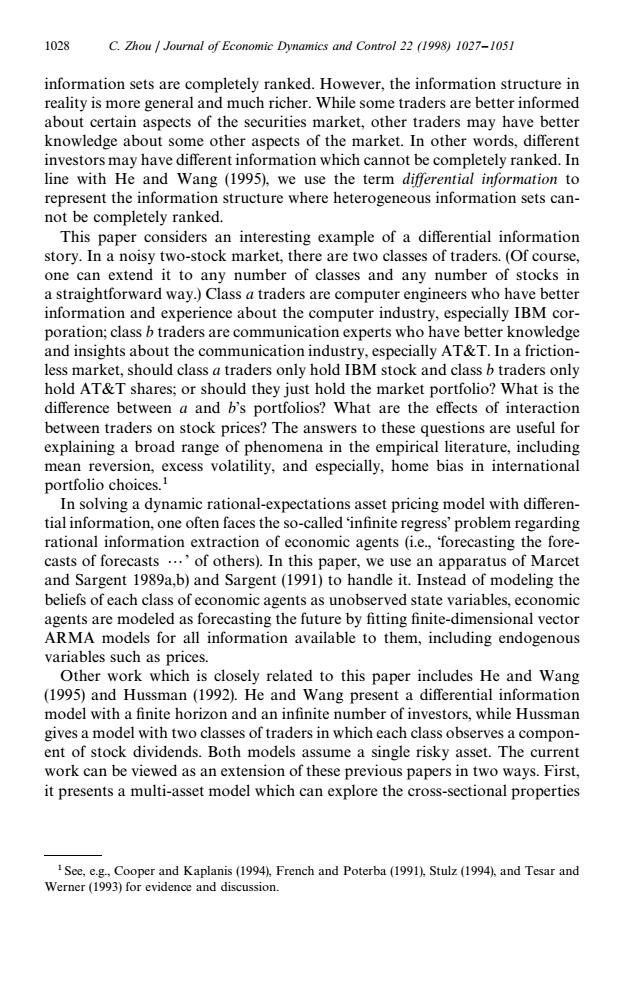正在加载图片...

1028 C.Zhou Journal of Economic Dynamics and Control 22 (1998)1027-1051 information sets are completely ranked.However,the information structure in reality is more general and much richer.While some traders are better informed about certain aspects of the securities market,other traders may have better knowledge about some other aspects of the market.In other words,different investors may have different information which cannot be completely ranked.In line with He and Wang (1995),we use the term differential information to represent the information structure where heterogeneous information sets can- not be completely ranked. This paper considers an interesting example of a differential information story.In a noisy two-stock market,there are two classes of traders.(Of course, one can extend it to any number of classes and any number of stocks in a straightforward way.)Class a traders are computer engineers who have better information and experience about the computer industry,especially IBM cor- poration;class b traders are communication experts who have better knowledge and insights about the communication industry,especially AT&T.In a friction- less market,should class a traders only hold IBM stock and class b traders only hold AT&T shares;or should they just hold the market portfolio?What is the difference between a and b's portfolios?What are the effects of interaction between traders on stock prices?The answers to these questions are useful for explaining a broad range of phenomena in the empirical literature,including mean reversion,excess volatility,and especially,home bias in international portfolio choices. In solving a dynamic rational-expectations asset pricing model with differen- tial information,one often faces the so-called'infinite regress'problem regarding rational information extraction of economic agents (i.e.,forecasting the fore- casts of forecasts ...of others).In this paper,we use an apparatus of Marcet and Sargent 1989a,b)and Sargent(1991)to handle it.Instead of modeling the beliefs of each class of economic agents as unobserved state variables,economic agents are modeled as forecasting the future by fitting finite-dimensional vector ARMA models for all information available to them,including endogenous variables such as prices. Other work which is closely related to this paper includes He and Wang (1995)and Hussman(1992).He and Wang present a differential information model with a finite horizon and an infinite number of investors,while Hussman gives a model with two classes of traders in which each class observes a compon- ent of stock dividends.Both models assume a single risky asset.The current work can be viewed as an extension of these previous papers in two ways.First, it presents a multi-asset model which can explore the cross-sectional properties See.e.g.Cooper and Kaplanis(1994),French and Poterba(1991),Stulz(1994),and Tesar and Werner(1993)for evidence and discussion.1 See, e.g., Cooper and Kaplanis (1994), French and Poterba (1991), Stulz (1994), and Tesar and Werner (1993) for evidence and discussion. information sets are completely ranked. However, the information structure in reality is more general and much richer. While some traders are better informed about certain aspects of the securities market, other traders may have better knowledge about some other aspects of the market. In other words, different investors may have different information which cannot be completely ranked. In line with He and Wang (1995), we use the term differential information to represent the information structure where heterogeneous information sets cannot be completely ranked. This paper considers an interesting example of a differential information story. In a noisy two-stock market, there are two classes of traders. (Of course, one can extend it to any number of classes and any number of stocks in a straightforward way.) Class a traders are computer engineers who have better information and experience about the computer industry, especially IBM corporation; class b traders are communication experts who have better knowledge and insights about the communication industry, especially AT&T. In a frictionless market, should class a traders only hold IBM stock and class b traders only hold AT&T shares; or should they just hold the market portfolio? What is the difference between a and b’s portfolios? What are the effects of interaction between traders on stock prices? The answers to these questions are useful for explaining a broad range of phenomena in the empirical literature, including mean reversion, excess volatility, and especially, home bias in international portfolio choices.1 In solving a dynamic rational-expectations asset pricing model with differential information, one often faces the so-called ‘infinite regress’ problem regarding rational information extraction of economic agents (i.e., ‘forecasting the forecasts of forecasts 2’ of others). In this paper, we use an apparatus of Marcet and Sargent 1989a,b) and Sargent (1991) to handle it. Instead of modeling the beliefs of each class of economic agents as unobserved state variables, economic agents are modeled as forecasting the future by fitting finite-dimensional vector ARMA models for all information available to them, including endogenous variables such as prices. Other work which is closely related to this paper includes He and Wang (1995) and Hussman (1992). He and Wang present a differential information model with a finite horizon and an infinite number of investors, while Hussman gives a model with two classes of traders in which each class observes a component of stock dividends. Both models assume a single risky asset. The current work can be viewed as an extension of these previous papers in two ways. First, it presents a multi-asset model which can explore the cross-sectional properties 1028 C. Zhou / Journal of Economic Dynamics and Control 22 (1998) 1027–1051